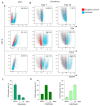HIV Modulates Osteoblast Differentiation via Upregulation of RANKL and Vitronectin
- PMID: 39338991
- PMCID: PMC11435243
- DOI: 10.3390/pathogens13090800
HIV Modulates Osteoblast Differentiation via Upregulation of RANKL and Vitronectin
Abstract
Bone loss is a prevalent characteristic among people with HIV (PWH). We focused on mesenchymal stem cells (MSCs) and osteoblasts, examining their susceptibility to different HIV strains (R5- and X4-tropic) and the subsequent effects on bone tissue homeostasis. Our findings suggest that MSCs and osteoblasts are susceptible to R5- and X4-tropic HIV but do not support productive HIV replication. HIV exposure during the osteoblast differentiation process revealed that the virus could not alter mineral and organic matrix deposition. However, the reduction in runt-related transcription factor 2 (RUNX2) transcription, the increase in the transcription of nuclear receptor activator ligand kappa B (RANKL), and the augmentation of vitronectin deposition strongly suggested that X4- and R5-HIV could affect bone homeostasis. This study highlights the HIV ability to alter MSCs' differentiation into osteoblasts, critical for maintaining bone and adipose tissue homeostasis and function.
Keywords: HIV; bone; osteoblasts; vitronectin.
Conflict of interest statement
The authors declare no conflicts of interest. The funders had no role in the design of the study; in the collection, analyses, or interpretation of data; in the writing of the manuscript; or in the decision to publish the results.
Figures




References
-
- McComsey G.A., Lupo S., Parks D., Poggio M.C., De Wet J., Kahl L.P., Angelis K., Wynne B., Vandermeulen K., Gartland M., et al. Switch from tenofovir disoproxil fumarate combination to dolutegravir with rilpivirine improves parameters of bone health. Aids. 2018;32:477–485. doi: 10.1097/QAD.0000000000001725. - DOI - PMC - PubMed
MeSH terms
Substances
Grants and funding
LinkOut - more resources
Full Text Sources
Medical

